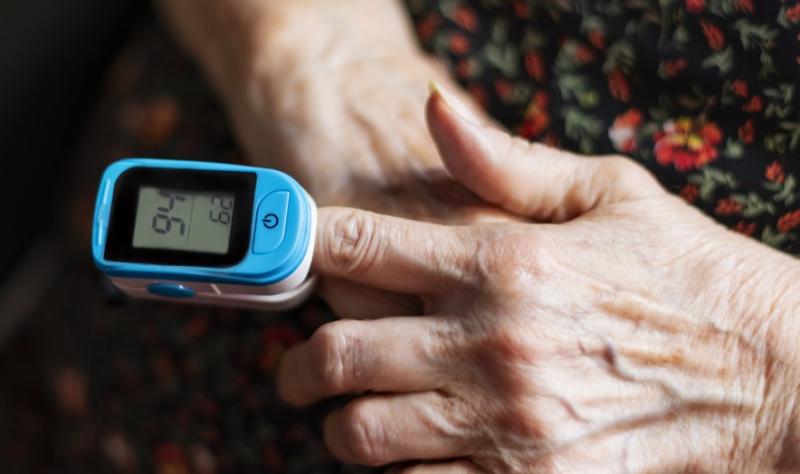Low and normal blood oxygen levels: What to know
Blood oxygen level is the amount of oxygen circulating in the blood. Doctors consider oxygen levels to be low when they are below 60 millimeters of mercury (mm Hg). Shortness of breath, dizziness, and other symptoms may occur.

Blood oxygen level usually range from 75–100 mm Hg. If they fall below 60 mm HgTrusted Source, there may not be enough oxygen reaching the body’s vital organs. This can lead to a range of symptoms.
The body closely monitors blood oxygen levels to keep them within a specific range so that there is enough oxygen for the needs of every cell.
A person’s blood oxygen level indicates how well the body distributes oxygen from the lungs to the cells, and it can be important for people’s health.
Normal and low blood oxygen levels
A healthy blood oxygen level varies between 75 and 100 millimeters of mercury (mm Hg).
When arterial blood gas (ABG) test results reveal an oxygen level below 60 mm HgTrusted Source, the medical community considers it low. In some cases, people with these results may require oxygen supplementation.
A blood oxygen level that is too low compared with the average level of a healthy person can be a sign of a condition known as hypoxemia. This develops when the body has difficulty delivering oxygen to all of its cells, tissues, and organs.
Oxygen saturation
Oxygen saturation refers to the percentage of oxygen in a person’s blood. Medical professionals often use a device called a pulse oximeter for either a quick test or continuous monitoring. The device can attach to the person’s fingertip.
A healthy oxygen saturation level ranges between 95% and 100%Trusted Source. If a person’s levels drop below this range, they may experience symptoms associated with a lack of oxygen, such as trouble breathing and confusion.
How is blood oxygen level measured?
An ABG test is a common wayTrusted Source to monitor blood oxygen levels. This test involves taking a blood sample from an artery, usually in the wrist. This procedure is very accurate, but it can be a little painful.
Doctors carry out ABG tests in a hospital. However, people can test themselves at home using a small device known as a pulse oximeter. A person cannot perform an ABG test at home.
A pulse oximeter is a small clip that often attaches to a finger, although it will also work on an ear or a toe. It measures blood oxygen indirectly by light absorption through a person’s pulse.
Although the pulse oximeter test is easier, quicker, and less painful than the ABG test, it is not as accurate. Several factors can interfere with the results, includingTrusted Source:
- dirty fingers
- bright lights
- darker skin tones
- nail polish
- poor circulation to the extremities
Symptoms of low blood oxygen levels
Low blood oxygen levels can result in abnormal circulation and causeTrusted Source the following symptoms:
- shortness of breath
- headaches
- restlessness
- dizziness
- rapid breathing
- chest pain
- confusion
- high blood pressure
- lack of coordination
- visual disorders
- sense of euphoria
- rapid heartbeat
Causes of low blood oxygen
The medical term for low blood oxygen is hypoxemia. It may happen due to:
- insufficient oxygen in the air
- inability of the lungs to inhale and send oxygen to all cells and tissues
- inability of the bloodstream to circulate to the lungs, collect oxygen, and transport it around the body
Conditions that can lead to hypoxemia
Several medical conditions and situations can contributeTrusted Source to the above factors, including:
- asthma
- heart diseases, including congenital heart disease
- high altitude
- anemia
- COVID-19Trusted Source
- chronic obstructive pulmonary disease (COPD)
- interstitial lung disease
- emphysema
- acute respiratory distress syndrome (ARDS)
- pneumonia
- obstruction of an artery in the lung
- pulmonary fibrosis, or scarring and damage to the lungs
- presence of air or gas in the chest that makes the lungs collapse
- excess fluid in the lungs
- sleep apnea, which involves breathing interruptions during sleep
- certain medications, including some narcotics and pain relievers
When to contact a doctor
People should contact a doctor if they:
- experience severe and sudden shortness of breath
- experience shortness of breath when at rest
- have severe shortness of breath that worsens during exercise or physical activity
- wake suddenly with shortness of breath or a feeling of choking
- are at high altitude and experience severe shortness of breath with a cough, rapid heartbeat, and fluid retention
Treatment
The treatment options for low blood oxygen levels include supplemental oxygen. Doctors can administer oxygen therapy in an office, or they can prescribe or recommend the use of home oxygen therapy (HOT).
A range of devices is available for delivering and monitoring HOT, but some require a prescription.
People can make lifestyle adjustments to reduce the symptoms of low oxygen levels, as well as improve their general health and quality of life. Changes that will likely be beneficial include:
- quitting smoking
- avoiding secondhand smoke
- eating a nutritious diet containing plenty of fruits, whole grains, lean protein, and vegetables
- exercising regularly
Outlook
Many conditions can cause low blood oxygen levels. Treating the underlying condition responsible will generally improve blood oxygen levels.
People living with chronic lung diseases, such as COPD, and those who catch COVID-19 may need regular blood oxygen monitoring.
People with low blood oxygen can also make lifestyle changes, such as adjusting their dietary and exercise habits. In conjunction with oxygen therapy, these changes could help a person raise their oxygen saturation levels.
Summary
A person’s blood oxygen level refers to the amount of oxygen circulating in their blood. A person can measure blood oxygen levels using a pulse oximeter. On a pulse oximeter, doctors consider levels under 95% to be low.
Several conditions can cause low blood oxygen levels, including asthma, anemia, and COVID-19.
The treatment will often involve addressing the underlying cause, but doctors may sometimes also recommend oxygen therapy or lifestyle modifications.
The articles on this website are for reference only and do not replace medical diagnosis or treatment. Please do not follow them on your own
Make a question

If you have any questions, please contact us via contact information, or fill in the form below.
Schedule a consultation appointment with the doctor
Before you leave, leave your information so we can send you medical news that may be of interest to you..

The doctor does not have an appointment scheduled, please choose another day

Note: The appointment time is only approximate, T-Matsouka will contact to confirm with customers after receiving the examination schedule information. Thank you for waiting for a response from T-Matsuoka.






Star rating:
Sort by :
No reviews yet.